
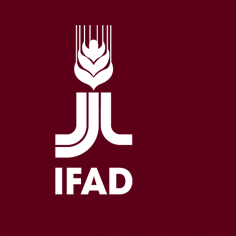
|
Water
Arsenic contamination in drinking water in Bangladesh
Arsenic contamination of groundwater has occurred in various parts of the world. Bangladesh has one of the highest levels of arsenic poisoning. Some estimates are as high as 80 million people who have been affected. Arsenic is a carcinogen which causes many cancers including skin, lung and bladder, and cardiovascular disease. During the recent IFAD review mission to the Sunamganj Community-Based Resource Management Project, it became apparent that the project is facing a major challenge due to arsenic contamination in the groundwater. The problem emerged during the mission’s extensive discussions and participatory evaluations with beneficiary groups, a workshop with project staff, and meetings with other stakeholders. Although the project area is subject to annual floods, there are severe shortages of water in the dry season and a lack of potable water at all times. Therefore, the original project design included a sub-component focusing on investment in tubewells for drinking water supply. By September 2006, the project had built 501 tubewells for domestic water. These investments are highly appreciated by villagers. However, the presence of arsenic in the groundwater could seriously compromise the project. The project commissioned the Bangladesh University of Engineering and Technology to analyse 293 of its tubewells, using a mobile testing kit. The study revealed that 46 per cent of the tubewells had arsenic above human tolerance levels. The review mission proposed a number of recommendations for immediate action in the second phase of the project. It has been agreed that the project will:
The review mission also recommended that the project explore alternative ways of providing safe drinking water. One alternative would be to use other sources of water – for example, collecting and filtering rainwater. Another alternative would be to purchase and distribute SONO filters to affected communities. SONO filters were developed by Abul Hussam, a professor of chemistry from Bangladesh. Water passes through three filtering systems composed of locally available coarse sand, wood charcoal and wet brick chips, and in the process the arsenic is removed from the drinking water. SONO filters are cheap, simple to use and virtually maintenance-free. In February 2007, Hussam received the 2007 Grainger Challenge Prize for Sustainability Gold Award of US$1 million for the SONO filter. The award recognized his innovative solution for removing arsenic from drinking water. The project management will analyse feasible options to address the arsenic contamination problem in the project area and implement cost-effective and viable solutions as soon as possible. Sheikh Mohsin, Project Coordinating Director, Sunamganj Community-Based Resource Management Project and Nigel Brett, Country Programme Manager Useful links:
Water brings light to the homes of Himalayan people
In March 2007, the project identified owners of traditional water mills in Tehri District of Uttaranchal and took them to visit water mills in Rudraprayag District that have been technologically upgraded to generate electricity. As a result of this visit, one of the project participants – Umaid Singh – not only improved his water mill but also installed a generator that produces 7.5 kW electricity power from the same water flow. The electricity is mostly used to generate light, but also has enormous potential to be used for food processing in the future. The project found that 7.5 kW of electricity can power 30 to 40 light bulbs and four televisions. In addition, the generators are not subject to frequent power cuts, as is the case with the power supplied through the national grid. “Previously, children could use power cuts as an excuse to stop studying in the evenings, but now they have continuous light and have to get down to work!” said Mahipal Singh, one of the beneficiaries. The project is planning to organize more exposure visits and support activities related to rural energy in the future. Martina Spisiakova, Newsletter Coordinator, and Jyotsna Sitling, Project Coordinator, Livelihoods Improvement Project in the Himalayas Read more about: The impact of agro-wells on livelihoods in Sri Lanka
Agro-wells are large-diameter (up to 4.6 metres) dug wells that allow larger quantities of water to be extracted at a time, which is used mostly for irrigation. The depth of agro-wells depends on the seasonal water table, which varies between 5.53 to 8 metres. Farmers construct and maintain the wells. In December 2006, Professor Anoja Wickramasinghe from the University of Peradeniya in Sri Lanka conducted a study assessing the impact of agro-wells on the lives of the farmers in the project area. The study covered 123 farm households that had agro-wells. Between 2001 and 2006, the project supported the construction of 756 agro-wells in Matale District of Sri Lanka.
The study revealed that agro-wells had become the primary source of water for irrigation where rainfall was inadequate or where it was available only during one season. Some of the key impacts of agro-wells are described below. Enhanced production and income Improved irrigation also enabled farmers to promote cash crops in highland areas during Yala and Maha seasons. The study reports increased production of cash crops in these areas by 20 to 160 per cent. As a result, seasonal hardship decreased for 71 per cent of the farmers. Increased property value and reduced maintenance costs Preserved natural resource base Improved health and well-being Improved linkages of small- and medium-scale producers with the market
Enhanced work opportunities for women There has been an increasing demand for agro-wells by farmers living outside of the project area because of the benefits mentioned above, but primarily because farmers see them as an investment with inter-generational benefits. Furthermore, the effects of climate change, especially the frequency of droughts, require that measures be taken to ensure that farmers living in dry areas are able to maintain secure livelihoods and economic stability. Martina Spisiakova, Newsletter Coordinator, and Sunil Fernando, Project Director, Read more about: Making the potable water system sustainable in Mindanao, Philippines
The Northern Mindanao Community Initiatives and Resource Management Project supports the ‘Level 2’ potable water system – a system in which water is stored in a common reservoir and distributed through pipes to common faucets for a cluster of five to ten households. Results show that the system has improved the health and sanitary conditions of the water users. But will operation and maintenance of the system continue after the project ends? The project team and its partners – local government units (LGUs), NGOs and community-based organizations (CBOs) – have been working on the sustainability concerns of the water system. Organizing the community
Building the capability of the community to maintain and operate the potable water system Maintaining water quality Generating and managing funds to operate and maintain the system Yolando Arban, IFAD Facilitator, Philippines Read more about:
Supporting improved water governance in the Mekong Region The diversity of uses and users of water resources and their management means that there are many opportunities for both cooperation and conflict. Some users have more opportunities to articulate their claims, concerns or needs than others. Efforts to empower disadvantaged groups to participate in broader negotiations are essential if their needs are to be addressed fairly and equitably. Effective water management requires more than just technical expertise: it is also essential to work on negotiation processes in order to include social and political dimensions. In line with its strategic objective to improve the access of poor rural people to productive assets, IFAD supports the Mekong Programme on Water, Environment and Resilience (M-POWER) through the Challenge Programme on Water and Food of the Consultative Group on International Agricultural Research (CGIAR). M-POWER is an action research programme funded by an IFAD grant of US$900,000, a contribution by the French government of EUR 600,000 and contributions by more than 20 partner organizations. The programme was created in 2005 as a platform that brings together organizations and individuals who share their commitment to making water governance a democratic process in the Mekong Region. A coordinated network of more than 20 partner organizations supports the programme. Young governance scholars, activists and policy-makers are encouraged to join programme’s activities as research fellows. One of M-POWER’s contributions to shaping policy and negotiations on water governance is by organizing and facilitating public events. Through this multi-stakeholder dialogue, the programme explores a broader range of solutions to the challenges of development and management of water resources. M-POWER believes that decisions over the development of regional waters are too important to the livelihoods of people in the Mekong Region to be left to a handful of individuals. Open deliberation and negotiations are needed to ensure sustainable and fair procedures and outcomes. M-POWER also mobilizes its network and partnerships to constructively critique and complement the work of other agencies. In this way, it provides decision makers with new and relevant inputs, voices and considerations and contributes to the social and political dimensions of the negotiation processes. Read more about: IFAD’s investment in the water sector in Asia and the Pacific IFAD’s loan investment in the water sector in the Asia and the Pacific Region (about US$170 million between 2000-2004) represents 15 per cent of its regional portfolio and about 5 per cent its total investment. While this ratio has been stable for the last 15 years, there have been some interesting changes, including increased cofinancing and a shift from investment in agricultural water to water for domestic use. Between 1990-1994 and 2000-2004 (the two five-year periods during which IFAD conducted the study), the proportion of IFAD’s total investment in the water sector increased from 25 to 35 per cent. For Asia and the Pacific it increased from 30 to 40 per cent. Over the last 15 years, the Asia and the Pacific Division maintained its contribution to the water sector from its loan financing but increased its cofinancing partnerships in water projects from 15 to 25 per cent. Another change lies in the investment in water sub-sectors. The table below shows that about 25 per cent of IFAD’s investment in the water sector in Asia and the Pacific shifted from investment in agricultural water (for irrigation, livestock and inland fisheries) to social water (for domestic uses). See the articles on Bangladesh and the Philippines for examples.
To support this shift, the Asia and the Pacific Division used loans to best leverage increasing partnerships. The proportion of IFAD financing in agricultural water diminished from 47 to 34 per cent, thus increasing the cofinancing share. While it increased its investment in social water, the division developed financial partnerships to decrease its investment share in social water from 61 to 42 per cent. Between 2000 and 2004, IFAD invested about US$170 million in the water sector in Asia and the Pacific to leverage another US$295 million. Audrey Nepveu, Technical Adviser on Water, IFAD Read more Partnering with the International Commission for Irrigation and Drainage The International Commission for Irrigation and Drainage (ICID) and IFAD have been talking about potential partnership in the water sector since September 2006, when ICID granted IFAD the status of permanent observer at its International Executive Council. Consequently, in December 2006, IFAD granted ICID the status of permanent observer at its Governing Council, in which ICID participated in February 2007. ICID is a professional association that focuses on synthesizing knowledge on irrigation and drainage, and providing opportunities for networking at the regional and global levels. For Asia and the Pacific, ICID is composed of 19 national committees and the Asian Regional Working Group. Based on ongoing discussions between IFAD and ICID since September 2006, a number of opportunities have emerged for future collaboration:
Audrey Nepveu, Technical Adviser on Water, IFAD Read more about: ‘Multiple use systems’ approach – enhancing the impact of water infrastructure on the livelihoods of rural poor people
This newsletter gives examples of various uses of water – for electricity generation in India; and for domestic, livestock and irrigation purposes in Sri Lanka and the Philippines. When designing development programmes and projects, one challenge is to adequately consider the multiple uses of water. The Challenge Programme for Water and Food of the CGIAR is currently financing a promising action research project on multiple use systems (MUS) that could prove useful for IFAD’s portfolio once the approach is mainstreamed, The MUS approach looks into how water systems can supply water to stakeholders and for diverse purposes effectively, efficiently and in a participatory manner. The approach addresses the challenge of designing water infrastructure that can accommodate a diverse range of users and user needs. It considers both productive and domestic usesto propose a design that will have a greater positive impact on the lives and livelihoods of poor people. Over the last three years since the project started, CGIAR identified 14 key conditions (or principles) that need to be in place at the community, intermediate and national levels to implement and scale up MUS (see box). Other organizations are taking an interest in the MUS approach. For example, ICID (see article above) and the Water and Sanitation Programme of the World Bank are promoting the approach. The French government is cofinancing the action research project of CGIAR on MUS; and Winrock International has allocated US$10 million for advocacy and capacity building in MUS. Audrey Nepveu, Technical Adviser on Water, IFAD Read more about:
Women continue to be excluded from water user associations
Over the last decade, tens of thousands of water user associations (WUAs) have been created worldwide. They are a result of institutional reforms to improve the management of water resources and give users a voice in decision making related to water management. One of the important challenges of these reforms is how to involve women and landless people in water management. In many Asian countries, such as Lao People’s Democratic Republic, India, Nepal, Pakistan and Sri Lanka, women’s participation in WUAs is lower than men’s. Women’s exclusion is often justified by the presumption that women do not physically practice irrigation. However, results from several studies, such as Zwarteveen’s ‘Wedlock or deadlock?: feminists' attempts to engage irrigation engineers’, show higher participation of women in irrigation activities. Membership in a WUA is often restricted to the registered landowners within a management unit who are engaged in farming on a full-time basis. These are very often men. When women are registered landowners, such as in South Asia, they are either represented by their male relatives or not at all. In Bhutan and Lao People’s Democratic Republic, the criteria for membership in a WUA are based on labour contributions in construction, operation and maintenance. In such cases, women may take part in these activities but are replaced by men relatives when it comes to the possibility of becoming a member of a WUA. Women and men have different priorities for water use. While men use water for irrigating cash crops or for livestock, women need water for growing staple crops, vegetables and kitchen gardens and for domestic use. If irrigation projects are to address the concerns of women and men, WUAs need to play an active role in managing water for multiple uses and users (see the article on the MUS approach). In some cases, affirmative actions have been introduced to ensure the active participation of women in decision making over water-related issues. Some WUAs are required by law to establish a minimum quota for women. Nevertheless, membership is often granted to local ‘elite’ women who are unfamiliar with the problems that poor rural women face. In some countries, such as in Nepal, women received leadership training and were able to take on leadership roles. Other countries, such as Bangladesh, have been successful in increasing women’s participation in WUAs by empowering them through the formation of women’s groups combined with disbursing agricultural credit. IFAD’s experience with WUAs has shown that affirmative actions are essential but not sufficient to ensure women’s participation in decision making for water management. Programmes and projects with supporting components, such as capacity development, access to capital and awareness raising, achieve better results in encouraging women to participate in WUAs and improving their livelihoods. Moreover, multiple use water systems tend to address women’s concerns better than mono-use irrigation projects. Robina Wahaj, IFAD consultant and Maria Hartl, Technical Advisor on Gender, IFAD Linking water practitioners through the Solution Exchange
The water community seeks to promote and offer solutions to its members in the following areas:
In July 2007, there were 1,960 members of the community. The members come from diverse backgrounds (as shown in the graph). Since its inception, the water community has had discussions on 67 issues. The issues can be classified into the following categories:
Some of the main outcomes of the activities of the community include:
To access individual consolidated replies regarding the topics mentioned above, you can become a member of the water community by contacting Pankaj Kumar Shrivastava, Resource Person, or Ramya Gopalan, Research Associate. Pankaj Kumar Shrivastava, Resource Person, Solution Exchange Read more about: Issue 3: History and spread of the self-help affinity group movement in India – the role played by IFAD Experience worldwide shows that when microfinance services reach poor rural people, particularly women, there are considerable improvements in incomes, child nutrition and education, family health and women’s empowerment. Self help groups (SHGs) were piloted by NGOs, notably MYRADA in India in the mid-1980s, to provide financial services to poor rural people. SHGs have now become a movement for social empowerment in India, particularly for poor rural women. This paper traces the origins and progress of the SHG movement in India from 1985 to 2006. It looks chronologically at the roles of NGOs, the National Bank for Agriculture and Rural Development and other banks, central and state governments, and IFAD as they entered into the movement. It also analyses the major factors contributing to or limiting the rapid expansion of SHGs in India. IFAD believes that this paper will be of interest to policy makers, development practitioners, academics and civil society and will enrich the understanding of SHGs. The paper was written by Aloysius P. Fernandez, Executive Director, MYRADA For more information, please contact Valentina Camaleonte, Asia and the Pacific Division, IFAD, Tel: +39 06/54592670 |
|||||||||||||||||||||||||||||||||||||||||||||||||||||||||||||||||||||||||||||||||||||||||||||
Join us at the 2nd World Congress on Agricultural and Rural Finance 31 October – 3 November 2007, Bangkok, Thailand The Asia-Pacific Rural and Agricultural Credit Association and the Bank for Agriculture and Agricultural Cooperatives of Thailand will host the 2nd World Congress on Agricultural and Rural Finance in Bangkok, Thailand from 31 October – 3 November 2007. The event is being organized in collaboration with the African Rural and Agricultural Credit Association, the Asociación Latinoamericana de Instituciones Financieras para el Desarrollo, the Confédération Internationale du Crédit Agricole and the Near East-North Africa Regional Agricultural Credit Association. IFAD is a co-sponsor of the congress. This year’s theme is ‘The contribution of agricultural and rural economies to sustainable and equitable development’. Within this theme the congress will focus on:
The congress will explore how these elements affect and impinge on the development of grassroots economies and the ability of rural financial institutions to provide appropriate and adequate financial and finance-related services. The congress will be an opportunity for chief executive officers and managers of financial institutions and international experts all over the world to exchange their experiences in and knowledge of rural and agricultural finance. The event is also an occasion for the international development community to participate in the exhibition and technical fair, where organizations can demonstrate successful projects and products that beneficiaries have made or used. Such interactions will also pave the way for new partnerships. If you are interested in joining the congress, please visit the World Congress website for more information.
|
|||||||||||||||||||||||||||||||||||||||||||||||||||||||||||||||||||||||||||||||||||||||||||||
![]()
|
|
[email protected] Martina Spisiakova
Making a Difference in Asia and the Pacific Issue 16: June-July 2007 Issue 15: Issue 14: January/February 2007 - Sustainable natural resource management Issue 13: November/December 2006 - PBAS: looking beyond the resource allocation system Issue 12: September/October 2006 - Communication for poverty reduction and rural development Issue 11: July/August 2006 - Working with UN agencies at the country level Issue 10: May/June 2006 - Indigenous peoples and ethnic minorities Issue 9: March/April 2006 - Access to land Issue 8: January/February 2006 - Agricultural Technology Management Issue 7: November/December 2005 - Pro-poor policies Issue 6: September/October 2005 - Gender & MDGs Issue 5: July/August 2005 - Partnership Issue 4: May/June 2005 - Rural Finance Issue 3: March/ April 2005 - Donor Harmonization Issue 2: January/ February 2005 Issue 1: November/ December 2004
91st Session of IFAD’s Executive Board, 11-12 September 2007 The following programmes and projects will be considered for approval: Maldives: Fisheries and Agricultural Diversification Project Bangladesh: Finance for Enterprise Development and Employment Creation Project Pakistan: Programme for Increasing Sustainability in Microfinance Regional Policy forum – Agricultural and Rural Development for Reducing Poverty and Hunger in Asia: In Pursuit of Inclusive and Sustainable Growth, organized by the International Food Policy Research Institute (IFPRI) and the Asian Development Bank (ADB), 9-10 August 2007, Manila Regional workshop – SCOPE, 17-18 September 2007, Bangkok Annual performance review workshop, 12-14 November 2007, Bangkok Bangladesh Cambodia China Loan negotiations – Inner Mongolia Autonomous Region Rural Advancement Programme, October 2007 Project completion mission – Wulin Mountains Minority-Areas Development Project, November 2007 Implementation support mission – Rural Finance Sector Programme, December 2007 Indonesia Kyrgyzstan Loan negotiations – Agriculture Investment and Services Project, November 2007 Mongolia Programme Progress Review workshop – Rural Poverty Reduction Programme, September 2007 Pakistan COSOP preparation mission – November-December 2007 Philippines Tajikistan Viet Nam Loan negotiations – Programme for Development of Market Opportunities for the Poor, November 2007
Upcoming international events: Water Loss 2007, 23-26 September 2007, Bucharest, Romania |
![]()
The International Fund for Agricultural Development (IFAD) is a specialized agency of the United Nations, dedicated to eradicating poverty and hunger in developing countries. Its work in remote rural areas of the world helps countries achieve the Millennium Development Goals. Through low-interest loans and grants, IFAD develops and finances projects that enable rural poor people to overcome poverty themselves.
IFAD tackles poverty not just as a lender, but as an advocate for the small farmers, herders, fisherfolk, landless workers, artisans and indigenous peoples who live in rural areas and represent 75 per cent of the world's 1.2 billion extremely poor people. IFAD works with governments, donors, non-governmental organizations, local communities and many other partners to fight the underlying causes of rural poverty. It acts as a catalyst, bringing together partners, resources, knowledge and policies that create the conditions in which rural poor people can increase agricultural productivity, as well as seek out other options for earning income.
IFAD-supported rural development programmes and projects increase rural poor people's access to financial services, markets, technology, land and other natural resources.
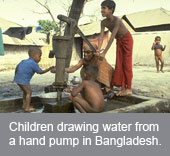 The review of the first phase of the IFAD-supported Sunamganj Community-Based Resource Management Project between December 2006 and February 2007 showed that the project is facing a major challenge: the project supports tubewells for drinking water supply, but the groundwater is contaminated by arsenic. The review mission recommended a number of immediate actions to address the problem.
The review of the first phase of the IFAD-supported Sunamganj Community-Based Resource Management Project between December 2006 and February 2007 showed that the project is facing a major challenge: the project supports tubewells for drinking water supply, but the groundwater is contaminated by arsenic. The review mission recommended a number of immediate actions to address the problem.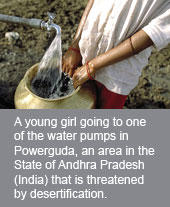 One of the many challenges faced by people living in remote areas of the Himalayas is their limited access to electricity power because of the high cost of energy supply from the national grid. As a consequence, many households continue to rely on energy supplies from wood, which is putting pressure on land and forests. The IFAD-supported Livelihoods Improvement Project in the Himalayas works to improve the livelihoods of poor people living in 1,730 villages of the most underdeveloped and remote areas of Meghalaya and Uttaranchal in India. Recently, in Uttaranchal, the project started addressing the need for energy security by helping poor people make the traditional water mills that are already being used to grind wheat into flour more efficient. It organized exposure visits for project participants who are using these traditional mills to villages that are using improved water mills that also generate electricity.
One of the many challenges faced by people living in remote areas of the Himalayas is their limited access to electricity power because of the high cost of energy supply from the national grid. As a consequence, many households continue to rely on energy supplies from wood, which is putting pressure on land and forests. The IFAD-supported Livelihoods Improvement Project in the Himalayas works to improve the livelihoods of poor people living in 1,730 villages of the most underdeveloped and remote areas of Meghalaya and Uttaranchal in India. Recently, in Uttaranchal, the project started addressing the need for energy security by helping poor people make the traditional water mills that are already being used to grind wheat into flour more efficient. It organized exposure visits for project participants who are using these traditional mills to villages that are using improved water mills that also generate electricity. 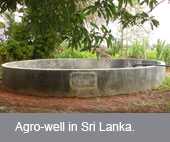 The IFAD-supported Matale Regional Economic Advancement Project works in relatively dry areas of Sri Lanka. Through the promotion of agro-wells as one of its activities, the project is trying to reach farm families that suffer from scarcity of rainfall, inadequate water supply and lack of access to modern irrigation services. IFAD is also trying to link these families with markets and improve their farming systems and practices in order for them to earn higher income and take advantage of economic opportunities in the future.
The IFAD-supported Matale Regional Economic Advancement Project works in relatively dry areas of Sri Lanka. Through the promotion of agro-wells as one of its activities, the project is trying to reach farm families that suffer from scarcity of rainfall, inadequate water supply and lack of access to modern irrigation services. IFAD is also trying to link these families with markets and improve their farming systems and practices in order for them to earn higher income and take advantage of economic opportunities in the future. 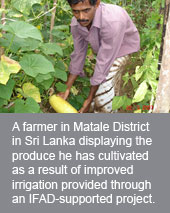 Improved social relations in villages
Improved social relations in villages The IFAD-supported Northern Mindanao Community Initiatives and Resource Management Project facilitated a potable water system that made a difference to 3,500 households in Mindanao in the Philippines. Can these benefits be extended to future generations? The project has been addressing the sustainability concerns of the potable water system by focusing on communities as key players in its operation and maintenance.
The IFAD-supported Northern Mindanao Community Initiatives and Resource Management Project facilitated a potable water system that made a difference to 3,500 households in Mindanao in the Philippines. Can these benefits be extended to future generations? The project has been addressing the sustainability concerns of the potable water system by focusing on communities as key players in its operation and maintenance.  IFAD’s Technical Division has been conducting a study on ‘Gender and Agricultural Water Management’. The study assesses the role of MUS in achieving water security for improved rural livelihoods. Some of the findings related to women’s exclusion from water user associations are described in this article.
IFAD’s Technical Division has been conducting a study on ‘Gender and Agricultural Water Management’. The study assesses the role of MUS in achieving water security for improved rural livelihoods. Some of the findings related to women’s exclusion from water user associations are described in this article.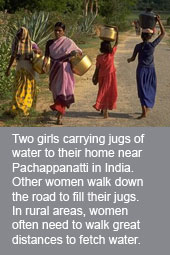 The Solution Exchange is a unique initiative of the United Nations in India. The initiative builds communities of development practitioners working in a common area of interest. It was introduced to the readers of Issue 12 (make link) of ‘Making a Difference in Asia and the Pacific’. The Solution Exchange - Water Community has been operating since June 2005.
The Solution Exchange is a unique initiative of the United Nations in India. The initiative builds communities of development practitioners working in a common area of interest. It was introduced to the readers of Issue 12 (make link) of ‘Making a Difference in Asia and the Pacific’. The Solution Exchange - Water Community has been operating since June 2005. 